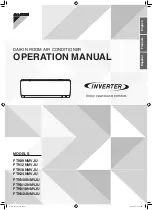
Refrigeration Maintenance
140
Pressure Rise Test
Evacuate the system and close valve V1. With
valves V3 and V4 open, the pump is isolated and
the system is held under a vacuum. If the micron
meter rises, one of the following conditions exist:
•
Leak: Watch the movement of the micron
meter needle. If the needle continues to rise
until it reaches atmospheric pressure, it is an
indication that a leak exists somewhere in the
system. When a leak is in a system, the
vacuum will eventually stabilize at
atmospheric pressure (see “Pressure Rise Test
Evaluation” in this chapter).
•
Moisture: When the needle indicates a rise and
then stabilizes at a level below atmospheric
pressure, it is an indication that the system is
vacuum tight, but is still wet and requires
additional dehydration and pumping time. See
Figure 89 “Pressure Rise Levels Off After
Evacuation Indicates Moisture in System”.
Factors Affecting the Speed of
System Evacuation
The time needed to evacuate a system can vary.
Some factors that can influence evacuation time
are listed below.
•
System size
•
Amount of moisture contained in the system
•
Ambient temperature
•
Internal restrictions within the system
•
External restrictions between the system and
the vacuum pump
Hose size, both diameter and length, affect
evacuation times. Laboratory tests show that the
evacuation time can be significantly reduced by
larger diameter hoses and shorter hoses. For
example, it takes eight times as long to pull a
given vacuum through a 6 mm (1/4 inch) diameter
hose as it does through a 12 mm (1/2 inch)
diameter hose. It takes twice as long to pull a
vacuum through a 2 meter (6 foot) long hose as it
does through a 1 meter (3 foot) long hose.
1.
Close the vacuum valve and watch the
movement of vacuum gauge needle. If needle
continues to rise, this is an indication that a
leak exists in the unit or connecting line. The
leak must then be located and eliminated.
2.
Time
3.
Pressure (Vacuum)
4.
Atmospheric Pressure
Figure 88: Constant Pressure Rise After
Evacuation Indicates System Leak
AXA0191
1.
Close the vacuum valve and watch the
movement of vacuum gauge needle. If needle
shows a pressure rise but finally levels off to a
constant pressure, the system still contains too
much moisture. Dehydration and additional
evacuation time are required.
2.
Time
3.
Pressure (Vacuum)
4.
Atmospheric Pressure
Figure 89: Pressure Rise Levels Off After
Evacuation Indicates Moisture in System
AXA0192
Содержание 098916
Страница 2: ...MAGNUM TK 51122 4 MM Rev 6 02 06 Copyright 2004 Thermo King Corp Minneapolis MN USA Printed in USA...
Страница 5: ......
Страница 11: ...Table of Contents 10...
Страница 19: ...Service Guide 18...
Страница 28: ...Specifications 27 Figure 2 Physical Specifications AMA313...
Страница 41: ...Unit Description Features Options 40...
Страница 105: ...Operating Instructions 104...
Страница 155: ...Servicing The Unit 154...
Страница 187: ...Index 186...
Страница 189: ...Wiring and Schematic Diagrams Index 188...
Страница 190: ...189 Wiring Schematic...
Страница 191: ...190 Wiring Diagram Page 1 of 2...
Страница 192: ...191 Wiring Diagram Page 2 of 2...
















































